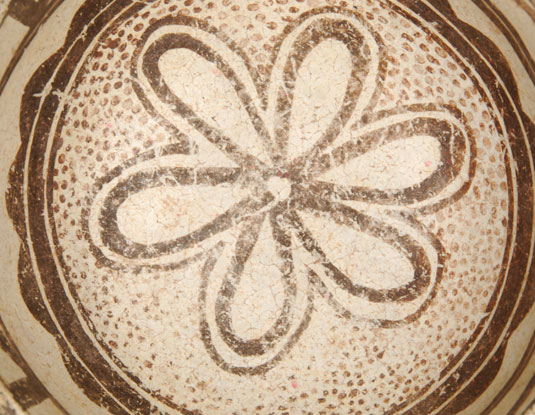Zuni Pueblo Small Bowl with Red Bottom [SOLD]
+ Add to my watchlist Forward to Friend
- Category: Historic
- Origin: Zuni Pueblo, SHE-WE-NA
- Medium: clay, pigment
- Size: 3-1/4” depth x 6-1/2” diameter
- Item # C3776A SOLD
It is recognized that changes in pueblo pottery occur about every decade with the maturity of a new generation of potters. These changes may not be significant or important and may not be explainable as to why they occurred. We have to accept that there was a reason or were reasons and appreciate that researchers have used these changes to assist in dating pottery.
One change that occurred at Zuni Pueblo was the abandonment of a red underbody on bowls and jars in favor of using a black pigment. It seems that this change began to be noticed around 1850. Over the next 45 years, red pigment was seen less and less on bases, and black appeared more frequently. By 1885, black pigment predominated and by 1895 the use of red disappeared.
Another diagnostic feature on pre-1900 bowls from Zuni is a design on the interior of the rim. The “stepped structure” that resembles a check mark has been documented on a small bowl collected by Stevenson in 1884 for the Smithsonian. Harlow and Lanmon, 2008 [Fig 16.20] This data is another indication that may be used for dating. A bowl with a red bottom and with a stepped structure band design would date between 1850 and 1885.
A design feature seen on pre-1900 Zuni jars and bowls is a sunflower or rosette consisting of petals. It is similar to designs seen on the side of the mask of the Salimopiya Katsina. It appears that early versions were simple black outline petals and later ones became more elaborate. A bowl with a simple rosette estimated to date between 1870 – 1880 was collected by Stevenson in 1882. Since the one collected by Stevenson exhibited significate patina from use, an 1870s date seems more appropriate.
Using these published data, it is logical to state that a bowl with a red bottom, a stepped structure design on the interior rim and a simple six-petal rosette would date between 1850 and 1870. This bowl featured here has those three qualities. The interior was executed entirely in black on cream, devoid of any use of red in the design. The exterior has red design elements outlined in black, sandwiched between designs executed solely in black.
The bowl has a black rim and double framing lines just below the rim and just above the red underbody. There is no obvious ceremonial line break on the exterior framing lines, however, a pair of very wide framing lines on the interior of the bowl does have a ceremonial line break. Perhaps that single line break was sufficient to satisfy the needs of the potter.
Another striking feature of this small bowl is the small concave curve of the exterior of the bowl about an inch below the rim. By including this in the construction, the potter added a feature that makes the bowl even more charming.
Condition: for a bowl of the age of this one, the condition is remarkable. There is some abrasion to the paint and one very minor rim chip on the interior rim.
Recommended Reading: The Pottery of Zuni Pueblo by Harlow and Lanmon
Provenance: from a private collection

- Category: Historic
- Origin: Zuni Pueblo, SHE-WE-NA
- Medium: clay, pigment
- Size: 3-1/4” depth x 6-1/2” diameter
- Item # C3776A SOLD



